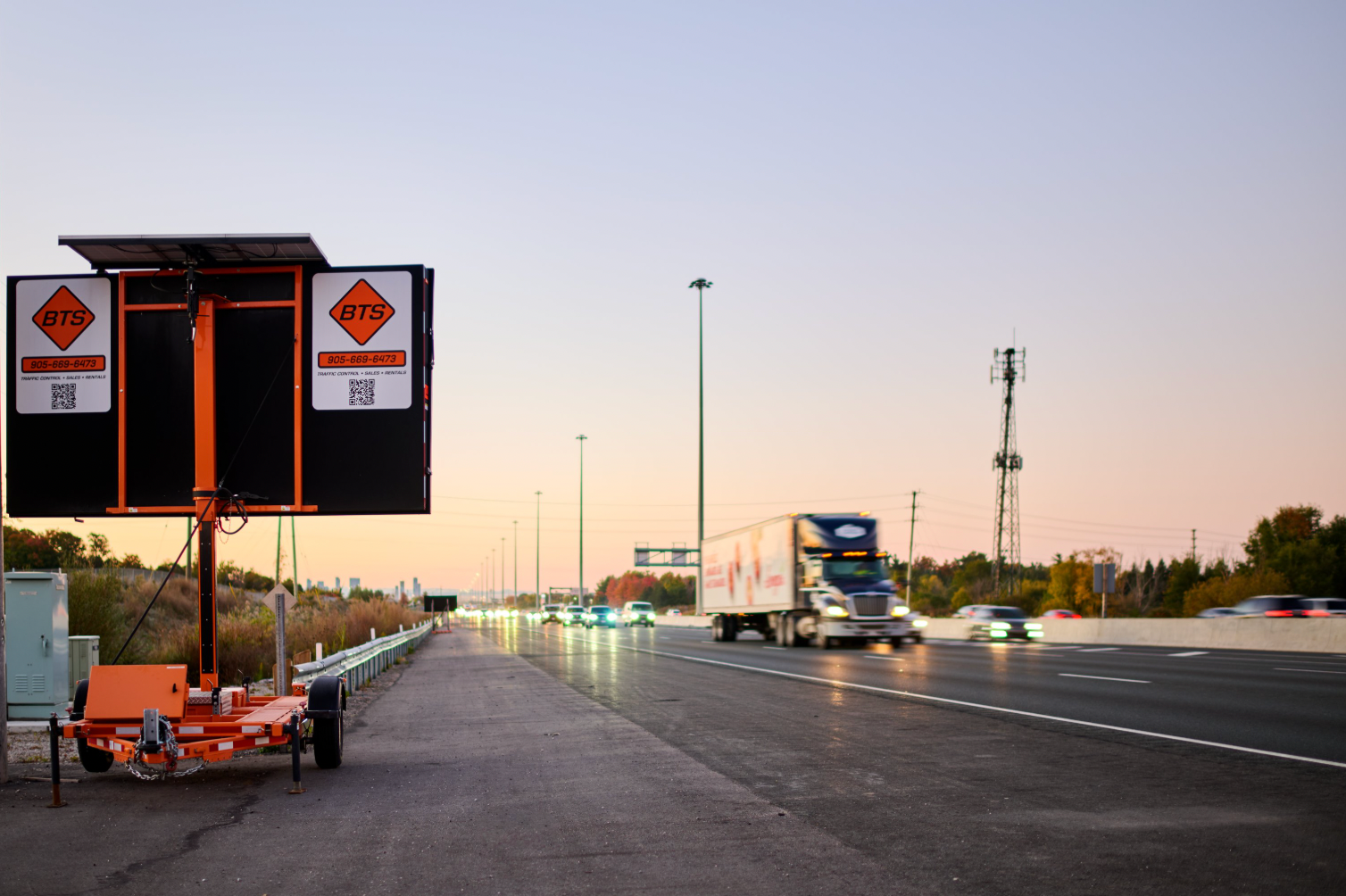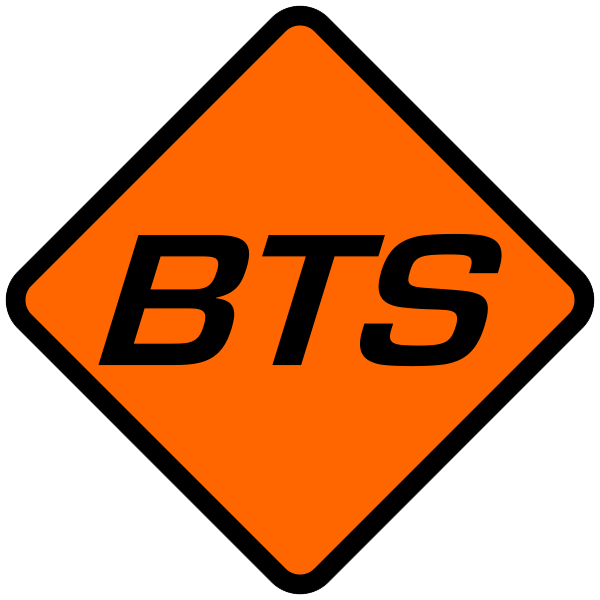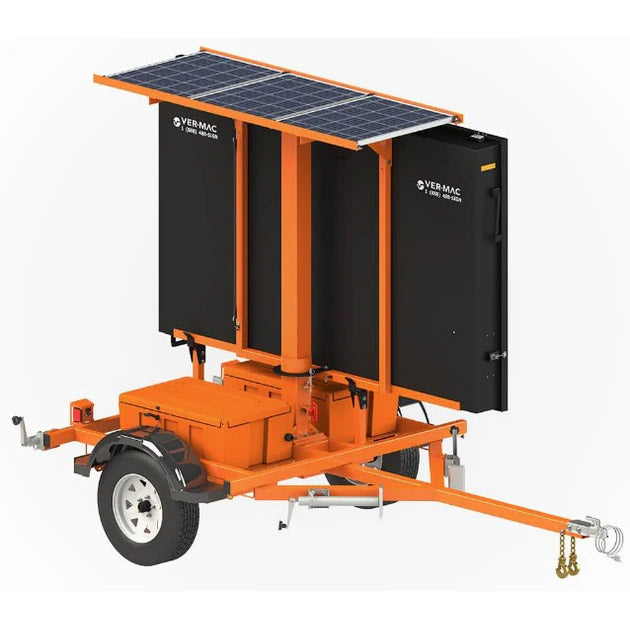
How Do PCMS Stay Bright in Full Daylight and Visible at Night?
When you drive past a construction zone or highway work site, you may notice a large digital message board glowing clearly—even under blazing sun or in the dead of night. These boards are often called PCMS (Portable Changeable Message Signs), and they serve critical roles in communicating traffic changes, warnings, and instructions.
How do they manage to stay legible both in harsh daylight and pitch-black conditions? In this blog, we’ll explore the technology, design strategies, and evolution behind these signs, and how they relate to modern construction signs and road construction traffic signs.
The Challenge of Visibility in All Lighting Conditions

Maintaining visibility across a full day is not easy. In bright sunshine, glare and ambient light can “wash out” displays, making messages unreadable. At night, a board that’s too bright can create glare, distract drivers, or strain the eyes.
A PCMS must balance being brilliant under sunlight and gentle enough after dark—all while conserving power. It must adjust to cloud cover, dusk, sunrise, and every lighting variation in between.
Additionally, these boards must endure weather, dust, heat, and vibrations—conditions common in construction and public works zones.
Core Technology: LEDs, Optics, and Intelligent Brightness

Modern PCMS units almost universally use LED (Light Emitting Diode) technology. LEDs offer many advantages: high brightness, low power consumption, long lifespan (often rated for tens of thousands of hours), and fast response. Because of these advantages, LED-based PCMS displays can remain clearly visible in daylight and dim themselves at night.
To make this work, designers incorporate several important features:
1. Automatic Dimming / Ambient Light Sensors
Most LED PCMS boards include ambient light sensors (photocells) that measure how bright it is outside. The system then adjusts the panel’s brightness up or down accordingly. In bright sunlight, it ramps up; at night or in darker conditions, it dims to reduce glare. These adjustments can be performed automatically to maintain visibility without manual intervention.
2. Lenses, Visors, and Optical Design
To improve brightness and control glare, many PCMS designs include optical lenses and visors over each LED pixel. These elements help focus light where it’s needed and shield it from stray angles or direct sun exposure.
This reduces wasted light and improves contrast. For example, one spec sheet describes snap-in optical lenses and polycarbonate visors that shade rows of pixels, helping the sign operate under full daylight while controlling power usage.
3. High-Contrast Displays and Color Choices
High-contrast displays (bright text on dark backgrounds) help messages stand out. Some PCMS units use amber or warm white LEDs because they perform well under broad light conditions. The pixel pitch (spacing between LEDs) and resolution also matter. A finer pixel pitch yields sharper text, especially when viewed from a distance.
4. Power Management and Efficiency
Because brightness demands more power, efficient control is essential. Many PCMS boards are solar-powered or battery-backed, so systems are optimized to use only as much energy as needed. Intelligent dimming and efficient circuitry help extend battery life and reduce solar panel needs.
Evolution of PCMS and Their Role in Modern Signage

Originally, many changeable message systems were flip-disk types, where disks physically flipped between a dark and reflective face. These worked okay under daylight but often struggled at night without backlighting. The move to LED and hybrid designs resolved many of those issues.
Over time, manufacturers added features like:
-
Remote dimming and control
-
Adaptive brightness levels
-
High-efficiency lenses and visors
-
Digital control systems that follow timing schedules
-
Integration with traffic management systems
Because of these enhancements, PCMS boards now contribute reliably to modern construction signs and construction traffic signs strategies. They complement static signs by providing dynamic messaging—detours, lane closures, warnings, and real-time updates.
To bridge the analogy, think about parking signage evolution: just as parking signs have gone from static metal plates to reflective, multi-faced, illuminated units, PCMS boards represent the “smart signage” evolution for traffic control.
PCMS in Action in Construction Zones and Road Projects

In road construction traffic signs environments, PCMS boards help:
-
Warn drivers of upcoming lane closures and merges
-
Display variable speed limits ahead of work zones
-
Redirect traffic during maintenance or detours
-
Inform drivers of delays or project timing
Because lighting conditions change during the day, PCMS systems help ensure that these messages aren’t lost (washed out) under high sun or too blinding at dusk. By staying legible, they support traffic control effectiveness and reduce crashes or confusion.
Designers of traffic control plans embed PCMS units in strategic spots—far enough ahead of work zones to allow reaction time, high enough for line-of-sight over obstacles, and oriented to minimize glare. In many jurisdictions, guidelines or policies dictate minimal mounting heights or offsets to optimize visibility. For example, certain CMS guidelines recommend raising displays at least seven feet from the ground in urban settings.
Also, when usage is long-term—as in multi-month infrastructure projects—PCMS durability and efficiency become critical. They must handle solar exposure, temperature swings, dust, and mechanical stress. The optical and power systems built into modern units ensure stable performance over extended periods.
Night Visibility, Glare Control, and Safety

At night, a too-bright board can act like a spotlight—creating glare or distracting drivers. The built-in dimming ensures the PCMS dims to safe brightness levels. Meanwhile, the use of visors, lenses, and controlled beam angles helps minimize light spillage and reduce interference with driver vision.
Well-designed PCMS units strike a balance: bright enough to be readable but modest enough to avoid dazzling drivers. This balance is critical in traffic safety systems.
Cleared messages at night also support law enforcement and maintenance crews, ensuring that instructions (e.g. “Detour Ahead,” “Road Closed”) remain readable even in darkness.
Practical Considerations and Maintenance

Even the most advanced PCMS systems require routine care:
-
Keeping solar panels clean helps ensure proper battery charging
-
Periodic cleaning of lenses, visors, and LED surfaces
-
Checking ambient light sensors for proper calibration
-
Verifying software for brightness settings and schedules
-
Ensuring physical orientation is correct (avoiding direct sun shine into sensors)
If a sign becomes too dim under daylight or too bright at night, that may indicate sensor fault or LED aging. In such cases, repair or replacement is needed.
________
PCMS units manage to stay bright in full daylight and still remain visible and safe at night thanks to a blend of advanced LED technology, intelligent brightness control, optical lenses/visors, and efficient power systems. These innovations turn what could be washed-out or glaring displays into reliable, readable messages in all conditions.
In the world of road construction traffic signs, construction signs, and dynamic traffic management, PCMS boards are now essential. They allow dynamic, real-time communication while adapting to changing light conditions.
For safety and effectiveness on your next project, make sure your message boards are built to see under sun and gleam by night. And if you’re looking for PCMS units and support, look to the experts at Barricade Traffic Services to supply, service, and help deploy reliable signage solutions. Use technology that helps protect drivers, workers, and the flow of traffic—get your PCMS units from Barricade Traffic Services today.




